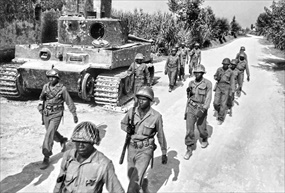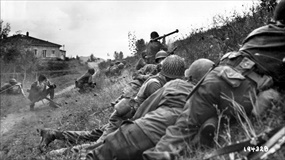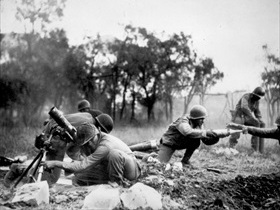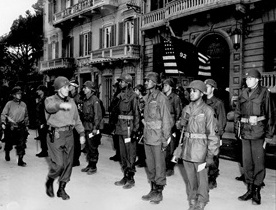92nd INFANTRY (BUFFALO) DIVISION ACTIVATED
Fort McClellan, Alabama • October 15, 1942
On this date in 1942 the 92nd Infantry Division was reactivated at Fort McClellan, Alabama. The famed African American infantry division, nicknamed “Buffalo Soldiers Division,” had served in World War I in France from July 1918 until it returned to the United States to be deactivated in February 1919.
The 92nd Infantry Division was one of 3 “colored” divisions activated in 1941–1942. The constant need for manpower and the spirited lobbying by First Lady Eleanor Roosevelt and members of the black community, particularly civil rights leaders and the press, wore down the War Department’s resistance to placing African American draftees and enlisted men in combat roles. The rank and file of the 3 “colored” divisions were trained and led by white staff officers and company commanders, who were mostly southerners. The first of the 3 divisions, a cavalry division, was activated in April 1941, but it was deactivated 2 months after arriving in Algeria, North Africa, in March 1944. Combat elements of the second division, the 93rd Infantry Division, nicknamed “Blue Helmets,” saw fighting in the Pacific Theater on Bougainville Island in March 1944 when they were attached to the Americal Division; however, most “Blue Helmets” were assigned to labor and security detachments and mopping up operations as the war against Japan wound down. Only the 92nd Infantry (Buffalo) Division under 51‑year-old Maj. Gen. Edward M. Almond saw serious combat in the final phases of the Italian Campaign of 1944–1945 as part of the U.S. Fifth Army under Generals Mark Clark and later Lucian Truscott. The first engagement with the enemy occurred on August 23, 1944, 3 weeks after the division’s 370th Infantry Regiment disembarked in Naples. Other elements of the 92nd arrived over the next 2 months, struggling against seasoned German troops in their laborious ascent up the Italian boot.
Relations between the 92nd’s white officers and the black rank and file exploded in hate-filled recriminations during the harsh 1944–1945 Italian winter. Maj. Gen. Almond and his white commanders blamed the division’s setbacks, low morale, unauthorized withdrawals upon engaging the enemy, and high casualty counts on black cowardice, while black GIs complained Almond and his “southern crackers” were using them as “cannon fodder.” U.S. Army Chief of Staff Gen. George Marshall had personally hand-picked the Virginia rising-star to command the almost exclusively black infantry division because he believed Almond would excel in a difficult assignment. But that was not to be. Almond began parroting the widespread prejudice in the segregated Army that blacks by nature made for poor front-line soldiers and thus were fit only for general service roles. He whined to confidants that the 92nd’s combat record had cheated him out of a higher command.
The Buffalo Soldiers emerged from the war with a mixed record of successes and failures, but also of honorable service to their country (see photo essay below). Many of its officers and men wore their Distinguished Service Crosses, Silver Stars, Purple Hearts, Combat Infantryman Badges, and Bronze Stars with pride. Their fighting was over, yet veterans of the Buffalo Division continued to come under fire from committed racists like Gen. Almond and his ilk. Their views were rejected by 3 decorated 92nd Division veterans: future U.S. senators Robert Dole of Kansas, Daniel Inouye of Hawaii, and Edward Brooke of Massachusetts.
The U.S. armed forces were still segregated when World War II ended, but things started to change in 1948 when President Harry S. Truman’s Executive Order 9981 mandated equal treatment and opportunity regardless of a servicemember’s race, color, religion, or national origin. Last to desegregate was the U.S. Army. Not until the end of 1954 was the last all-black unit disbanded. Officially racial segregation had been eradicated in the U.S. military, yet there was still room for improvement. There still is.
U.S. Army’s 92nd Infantry Division During World War II
 |  |
Left: Fighting men of the 92nd Infantry Division, the famed Buffalo Soldiers, march past the wreckage of a knocked-out PzKpfw VI Tiger tank in the vicinity of Ponsacco, Italy. Ponsacco is a municipality in the Province of Pisa in the Italian region of Tuscany and is located about 30 miles/48 km southwest of Florence.
![]()
Right: Soldiers of the 92nd Infantry Division engage the German enemy on September 7, 1944, 3 miles/4.8 km north of the town of Lucca, Italy. Famous for its fantastic medieval city walls that pedestrians and bicyclists can navigate, Lucca is 23 miles/37 km north of Ponsacco. A soldier rises up to fire a bazooka at a German machine-gun nest just 30 yards/21 m from the American position, while at left an Italian partisan, one foot on the dirt path, the other on grass, covers his ears.
 |  |
Left: Members of a field artillery battalion of the 92nd Infantry Division pass the ammunition and heave it over at the Germans in an almost endless stream near Massa, Tuscany, some 200 miles/322 km north of Rome, the former capital of the Italian dictator Benito Mussolini, November 1944. The battalion was credited with liquidating several enemy machine-gun nests.
![]()
Right: Virginia-born Maj. Gen. Edward Almond took command of the 92nd Infantry Division the month it was activated. He had previously served as assistant division commander of the newly raised 93rd Infantry Division. In this photo Almond is seen inspecting his troops, which at the moment included the highly decorated Japanese American (Nisei) 442nd Infantry Regiment, during a decoration ceremony in Italy, March 1945. Almond grew up in the “Jim Crow” South and claimed he “understood the character of the Negro and his habits and inclinations . . . and Negro capabilities.” Totally lacking class and tact but with friends in high places (he married the sister of Army Chief of Staff Gen. George Marshall), he once told one of his black regiments, “I did not send for you. Your Negro newspapers, Negro politicians, and white friends have insisted on your seeing combat, and I shall see that you get combat and your share of casualties.”
Tribute to Buffalo Soldiers in Italy, 1944–1945
![]()

 History buffs, there is good news! The Daily Chronicles of World War II is now available as an ebook for $4.99 on Amazon.com. Containing a year’s worth of dated entries from this website, the ebook brings the story of this tumultuous era to life in a compelling, authoritative, and succinct manner. Featuring inventive navigation aids, the ebook enables readers to instantly move forward or backward by month and date to different dated entries. Simple and elegant! Click
History buffs, there is good news! The Daily Chronicles of World War II is now available as an ebook for $4.99 on Amazon.com. Containing a year’s worth of dated entries from this website, the ebook brings the story of this tumultuous era to life in a compelling, authoritative, and succinct manner. Featuring inventive navigation aids, the ebook enables readers to instantly move forward or backward by month and date to different dated entries. Simple and elegant! Click 











